Microsoft, Google, IBM CEOs Talk Future Of Cloud With NetApp CEO Kurian
“For many years, we’ve been saying that the world’s changing. But no one could have predicted the amount of change we’ve seen in 2020. Despite all the challenges over the past few months, we’ve learned a lot about ourselves and each other,” says NetApp CEO George Kurian.
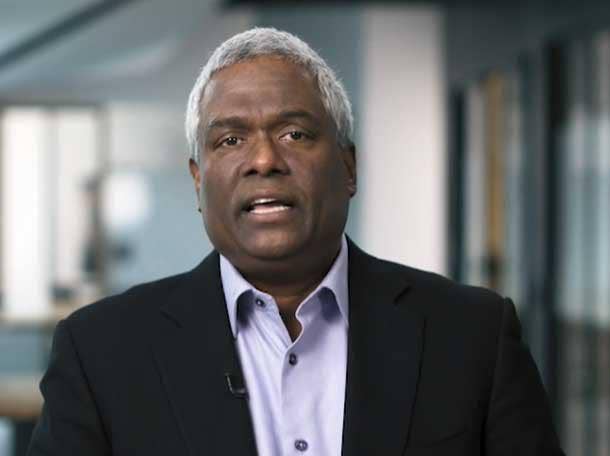
Getting By With A Little Help From Friends (And A Brother)
NetApp CEO George Kurian said that the world is quickly changing as businesses accelerate their digital transformation not only because of the COVID-19 coronavirus pandemic, but because of the need to adopt ever more hybrid cloud capabilities as a way to add flexibility to their business and better serve clients.
“For many years, we’ve been saying that the world’s changing,” Kurian told an audience of enterprise customers and solution providers during last week’s NetApp Insight 2020 virtual conference. “But no one could have predicted the amount of change we’ve seen in 2020. Despite all the challenges over the past few months, we’ve learned a lot about ourselves and each other.”
However, NetApp and Kurian understand that helping businesses with their digital transformation is too big a task for one company alone, but instead requires data center infrastructure providers and cloud providers to work together towards building hybrid clouds.
To emphasize that point, NetApp invited the CEOs of three of the biggest names in the cloud--Google, Microsoft, and IBM--to the NetApp Insight stage to talk about the parts they play in digital transformation and how they are partnering with NetApp to do so.
Those conversations included a face-to-face meeting between George Kurian and his twin brother, Thomas Kurian, CEO of Google Cloud, in what may be the first public joint presentation by twin CEOs of two of the most powerful companies involved in digital transformation and public and hybrid cloud development.
For a unique look at the future of IT and the importance of partnerships at the highest levels, turn the page.
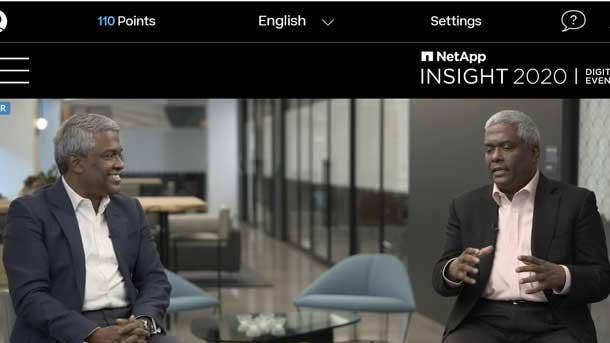
Thomas Kurian, CEO, Google Cloud
NetApp CEO George Kurian was visited in-person by his equally famous twin brother, Google Cloud CEO Thomas Kurian.
George Kurian introduced Thomas Kurian as, “My best friend, and distinguished CEO of Google Cloud, Thomas Kurian, my twin brother who has been with me my entire life.”
Thomas Kurian said businesses look to cloud providers for two important things. The first is around lowering IT costs to better face economic challenges and to use the cloud as a mechanism for a more efficient and agile IT infrastructure. The second is the shift to digital business as companies look to new innovations to change their business models to take better advantage of the power of data.
“And that‘s where the collaboration between Google Cloud and NetApp come together,” Thomas Kurian said. “We’ve had the great fortune of working together to solve business problems for lots of customers. ... NetApp’s teams have done an awesome job of working with us to deliver common solutions that improve performance, scale, ease of migration, and transform the business value of data to solve business problems for customers.”
Looking forward, Thomas Kurian said, Google and NetApp will continue to work together on joint solutions.
This includes working together to bring Google cloud technologies to enterprises with a broadening solution catalog, and expanded solutions portfolio that includes hybrid and private cloud offerings for virtual machines and container-native solutions, bringing Google’s Anthos multi-cloud Kubernetes offering to those businesses, and new capabilities for areas including mission-critical analytic applications and virtual desktops, he said.
The two will also strengthen their customer service organizations so that customers who deploy mission-critical workloads in the cloud can get collaborative support with super-critical response time, he said.
“Third, we continue to invest in bringing our sales organizations together so that customers can find it much easier to contract our joint solutions to get the expertise from both our organizations: your deep understanding of customers and their storage requirements, and our expertise in cloud computing,” he said.
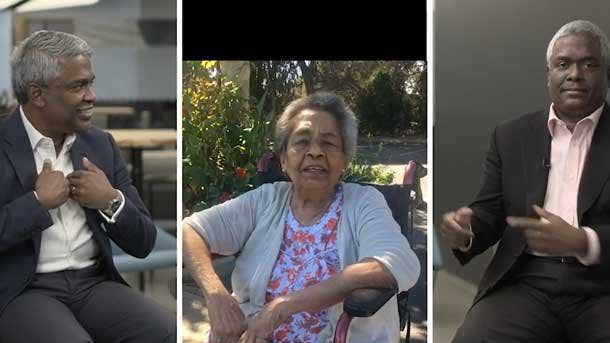
George? Thomas?
NetApp’s new president, Cesar Cernuda, introduced Thomas Kurian as joining the stage, and asked the question that was on many attendees’ minds: Which is George Kurian and which is Thomas Kurian?
Cernuda called on an expert, Molly Kurian, mother of the two, for help.
“Hello, everybody,” Ms. Kurian said. “George is the one with the pink shirt.”
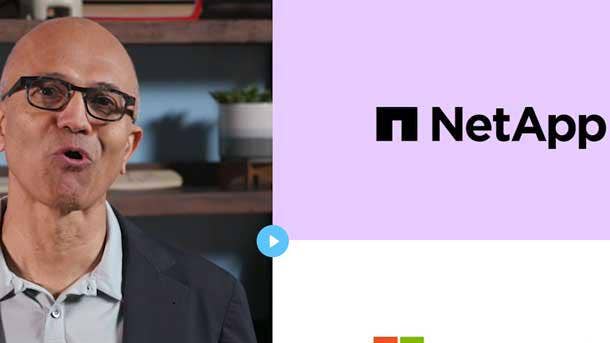
Satya Nadella, CEO, Microsoft
NetApp’s George Kurian introduced Nadella by noting the 25-year partnership between NetApp and Microsoft that started with developing unified storage for file and block back when Nadella was the leader of Microsoft‘s Windows Server Group. That relationship has long since expanded to the cloud, Kurian said.
“The work we‘re doing with Azure and NetApp files, as well as [NetApp’s] core work around building a storage operating system and how we bring these two things together to support our customers’ need for hybrid infrastructure, has been breakthrough work,” Nadella said. “And you see it in terms of our customers.”
It is fascinating to see the impact the Microsoft and NetApp partnership has had on common customers‘ digital transformation outcomes, Nadella said.
“[George and I care about] the agility that is needed to really derive value out of product technologies,” he said. “And I think that‘s one of the place where we’re seeing really transformative impact of our two companies coming together.”
Nadella cited a few lessons he has learned based on his experience in helping lead the digital transformation of Microsoft‘s customers.
The first, he said, is that in a time of great change, businesses have to get a lot of things right.
“You‘ve got to get where the technology is going, what are the industry forces that are secular changes, how do you pick your strategies right, and then of course execute,” he said. “But perhaps most important for all of us as leaders is to understand more deeply what are the necessary conditions that even help you deal with change, and massive change. ... When we talk about digital transformation, every business is becoming a software business. So that’s what we’ve gone back to, our very core roots, doing things not out of envy, but doing things out of our core purpose.”
The other thing businesses must get right is culture, which Nadella defined as the lived experience of employees that determines a company’s success.
“It‘s not just talking about it and putting up posters, but lived experience, starting with me, is the most important,” he said. “As leaders, you have to make the case for change before change happens.”
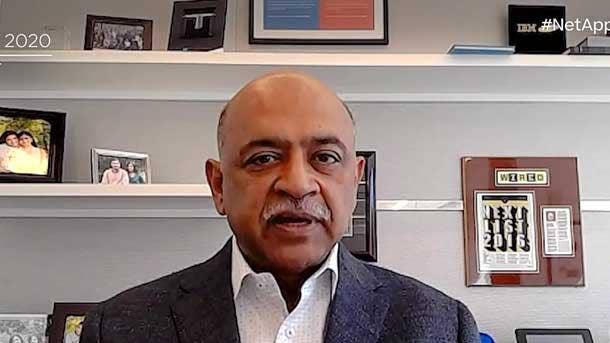
Arvind Krishna, CEO, IBM
NetApp and IBM have been working together for 20 years, Kurian said when introducing Arvind Krishna, IBM CEO, to discuss IBM’s cloud business. The conversation follows the unveiling last month of IBM’s plan to split its managed infrastructure services unit into a separate company, leaving IBM itself focused on its hybrid cloud platform and A.I. capabilities.
Krishna, who was named IBM CEO early this year, said the world is simultaneously going through a health crisis, an economic crisis, and a justice crisis.
“With that, you always have to look at what is the opportunity in all of these crises,” he said. “And I will tell you that we fundamentally believe that all these crises have acted as an accelerator.”
That accelerator is around three different vectors, Krishna said.
The first vector is the accelerating move towards digitization by every business and government organization. “We can debate whether what was going to take five years will now take two years, or what was going to take three years is now going to take one year,” he said.
The second vector of change is all around hybrid cloud. So far, maybe 20 percent of workloads have moved to the cloud, and is a lot lower for regulated industries, betting the question of why the rate of adoption is so low, Krishna said.
“And so all of the questions around latency, sovereignty, and where people start from come into play,” he said. “But it clear that, with this crisis, the rate of adoption of cloud and towards hybrid cloud is increasing.”
The third area, artificial intelligence, which has the potential to have a $16-trillion impact on productivity over the next decade, Krishna said.
“But we‘re only 4 percent of the way in,” he said. “And that is such a low number that it offers us massive opportunity, and every client we talk to wants to unlock value from data. And A.I. offers the only path forward.”
IBM‘s definition of “hybrid cloud” is the integration of what is in businesses’ data centers, multiple public clouds, SaaS properties, and private clouds, Krishna said.
“And I would say that‘s not a way stop,” he said. “That probably is the destination.”